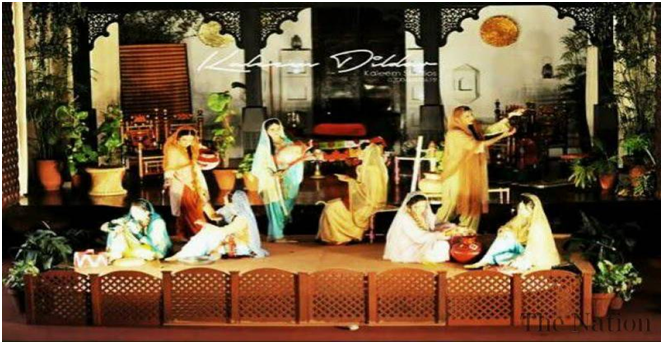

Thus Heer Spoke has become an essential part of Kinnaird’s heritage. Not only has it carved
a niche for itself in the records of theatre and drama, but has also become a play that has
introduced new standards and avenues

Sofia Arslan Qadeer
On Shakespeare’s birth anniversary last year, the Globe Theatre touring the whole world, re-
enacting Shakespearean plays, handpicked Kinnaird College solely out of the whole country
as its venue to stage Hamlet. All credits for this glorious accomplishment are directed towards
none other than the Kinnaird College Najmuddin Dramatics Society. The Society traces its
history back to 1950s, when it started engendering productions on a massive scale. The
society’s hallmark has been its flawless efforts in re-enacting Shakespearean and Shavian
plays with the same fervor and zest with which it has produced bilingual home productions.
It is not only one of the chief pioneers of theatre in Pakistan, but has earned veritable
international recognition over the course of time, producing plenty of incomparable actors in
modern times including Shamim Hilali, Madiha Gauhar and Nadia Jamil.
This year, a radiant performance was staged that not only mesmerized the audiences as a
reflexive action, but was also one that would assuredly remain firmly deep-seated within the
minds of the watchers for many coming years whenever they would come face to face with
the poetic romance, Heer Ranjha. Kinnaird College for Women’s Najmuddin Dramatics Society
based its annual play this year upon the vibrant Punjabi cultural paraphernalia. With the
blinding effulgence of color and panache, the fecundity of flowers, traditional diyas and the
most accurate standards of lights and sounds, Thus Heer Spoke was truly a masterpiece.
Dr. Nadia Anjum, who is the Advisor of the Najmuddin Dramatics Society and Head of the
MA/M.Phil English Literature Department at Kinnaird, herself wrote the script, bringing together
verses from the sufi poetry of Munir Niazi, Hazrat Sultan Bahu, Hazrat Baba Bulleh Shah and
Waris Shah’s Heer. The play was one well-scripted, thoroughly researched and a versatile,
multi-textual one. The play highlighted nefarious incongruities in the society and how its
various factions like religion, the social gaze and the common conventionalities cave in at a
woman, marginalizing her to the peripheries. The Heer in the play voiced her inner conscious-
ness, her mental turmoil and the psychological baggage that she was fronted with—this in
itself was an idea conceived by the Najmuddin Dramatics Society: to embed the script in a
background that could serve as a vehicle for the articulation for all muzzled women in this
part of the region.
The play spoke on behalf of all girls who are introduced to a readymade formula of life that
they are required to strictly adhere to. The play showcased how by venerating social principles
taught by mothers and other matriarchs in the household, girls might become women emble-
matic of social perfection later in life, but in the process of making them pay acquiescence to
the “does and don’ts” of life, they are dispossessed of their fundamental right to be themselves
and retain their individualities. The Heer in the play presented modern arguments which
emphasized on her being the voice endeavoring to break away from the swaddles of imprisoning
social constructs that otherized her within the four walls of her own house.
The whole script being in wholesome Punjabi linguistic facility and backed with the lushness of
a metaphysical narrative enhanced the pristine expression of the play. From the seven sahelis
of heer representing the seven levels of mysticism, to the beggar articulating a poetic gesture
in argument of the masts of social constructs, symbolically acting as a chorus and reciting
Hazrat Baba Bulleh Shah’s and Sultan Bahu’s sufi aphorisms, made the play display a collage
of traits from Grecian tragedy and Punjabi folklore with a socio-political dimension to it.
Even the most miniscule of the details regarding costumes, accessories and stage props were
taken special care of by Dr. Nadia Anjum and the President, Syeda Minaal Ali.
After months of investing sheer hard work and burning midnight oil, the unremitting and
incessant efforts by the team bore fruit and the play became a massive hit, enticing huge
crowds for four consecutive days. It can be undoubtedly stated that Thus Heer Spoke has
become an essential part of Kinnaird’s heritage; not only has it carved a niche for itself in
the records of theatre and drama, but has also become a play that has introduced new
standards and avenues for motivations to produce such literary marvels in the times to come.
Sofia Arslan Qadeer takes profound interest in politics and literature. She is a former feature-writer at The News on
Sunday and currently the President of the Kinnaird College Debating Society
Source:The Nation, May 03, 2017
Send email to nazeerkahut@punjabics.com with questions, comment or suggestions
Punjabics is a literary, non-profit and non-Political, non-affiliated organization
Punjabics.com @ Copyright 2008 - 2018 Punjabics.Com All Rights Reserved
Website Design & SEO by Webpagetime.com